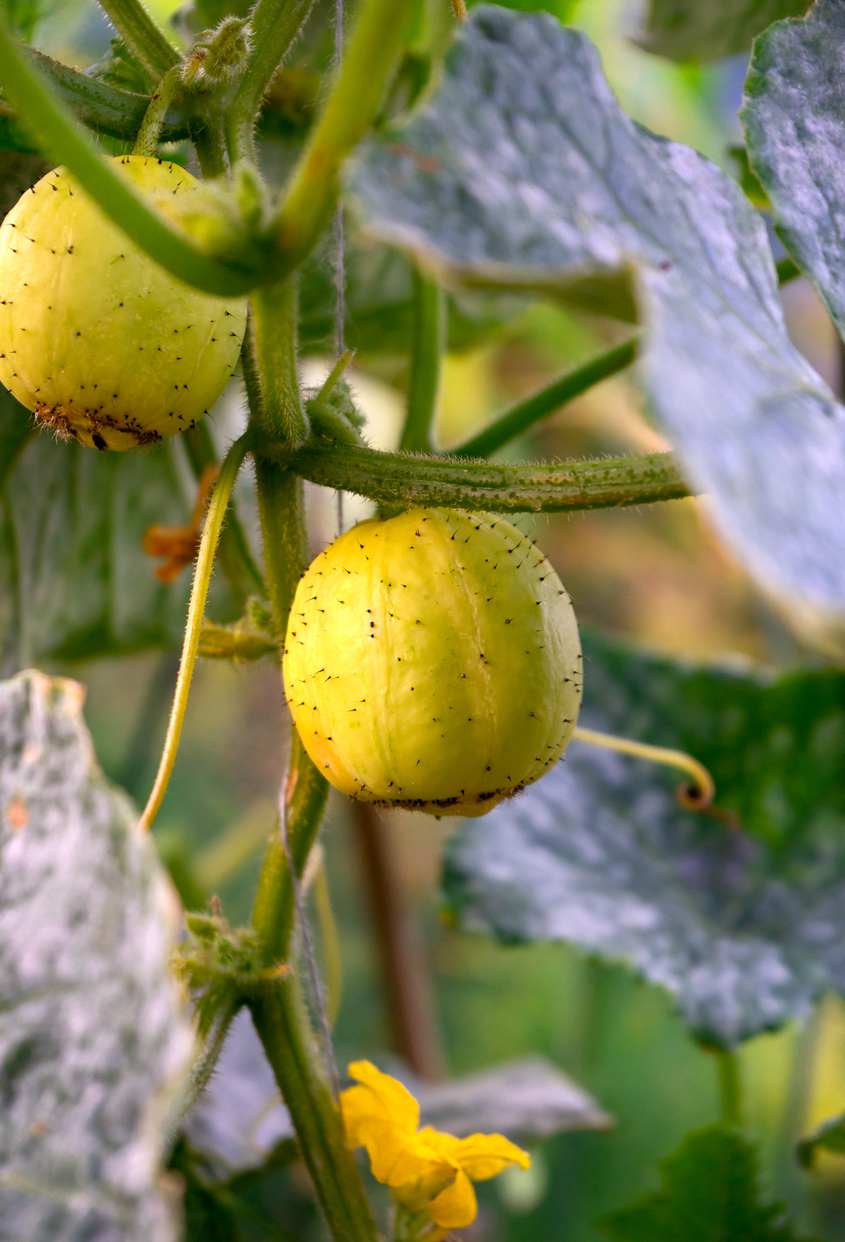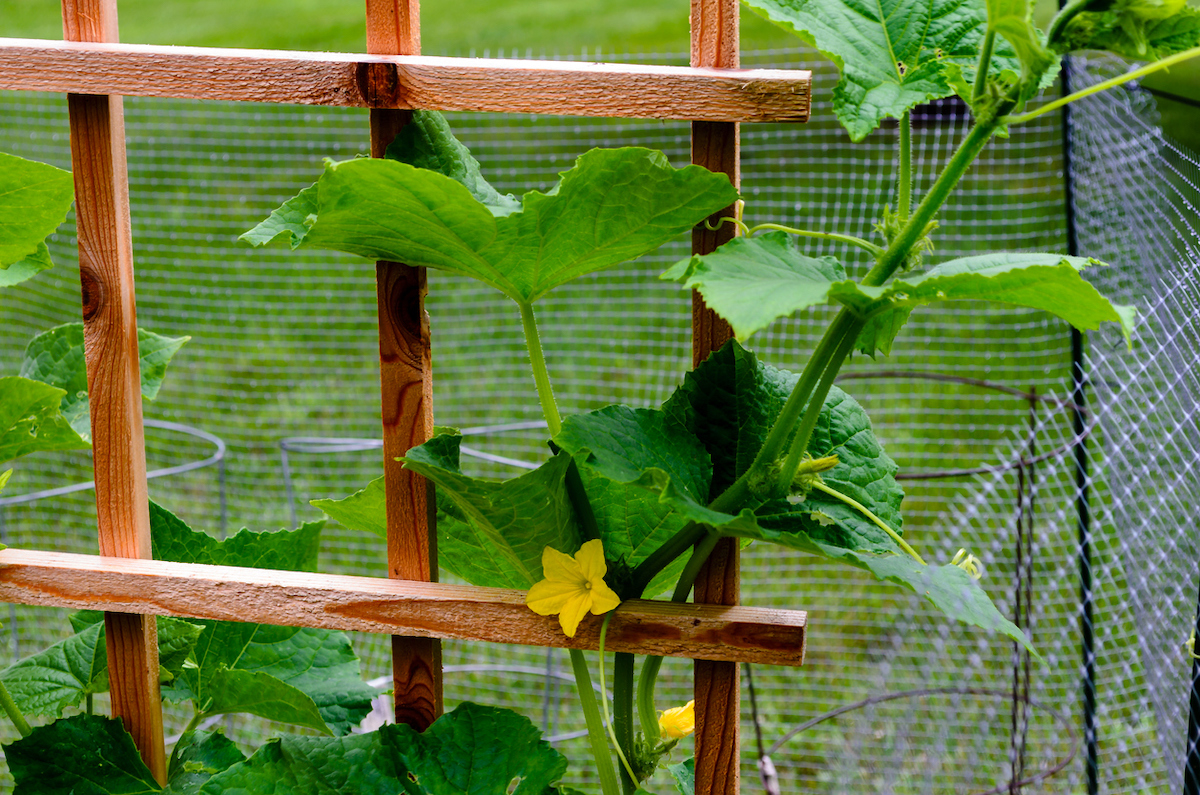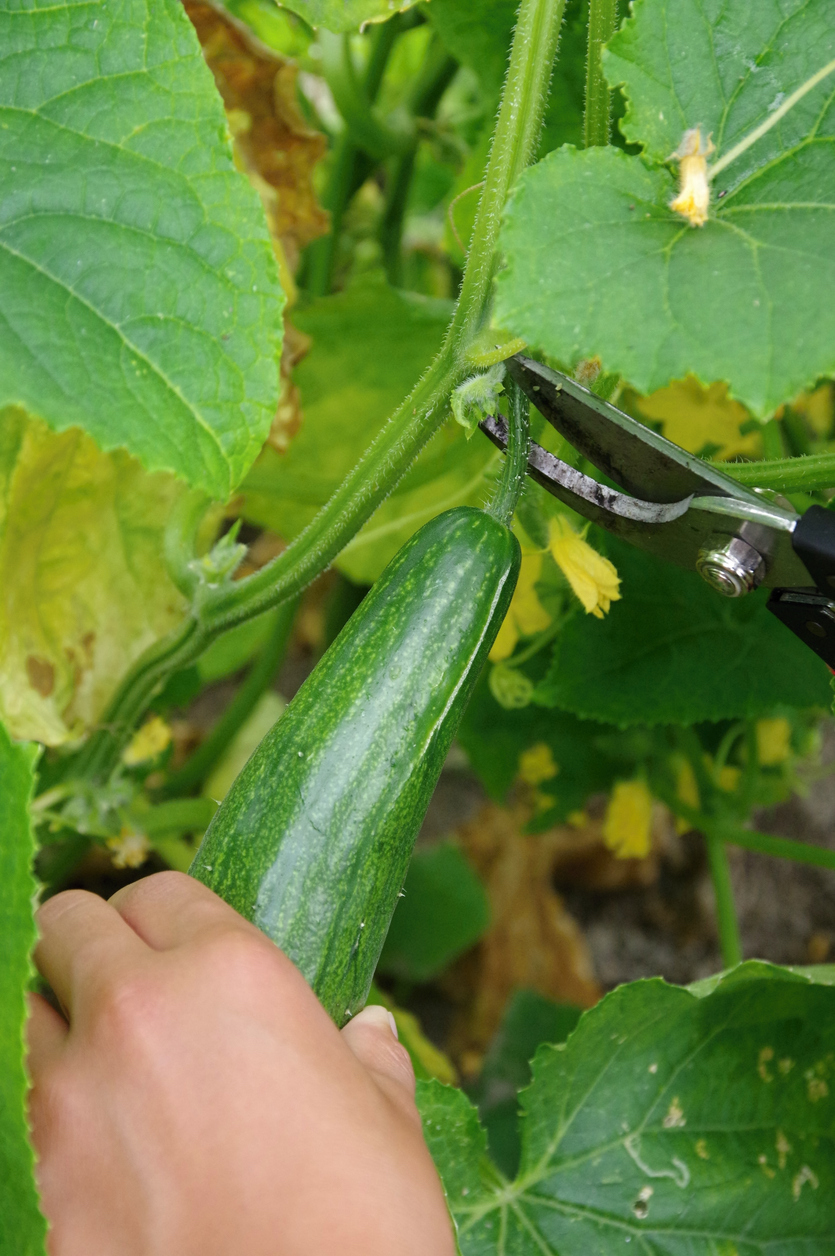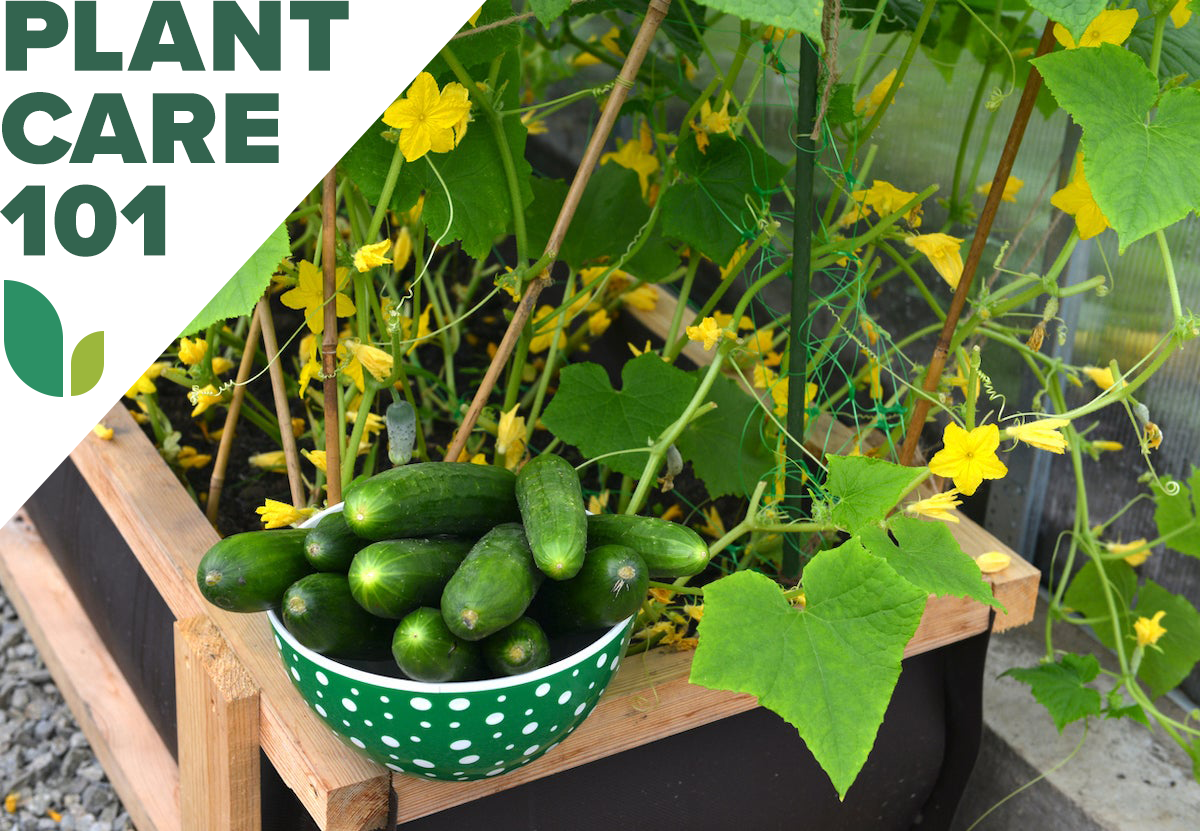We may earn revenue from the products available on this page and participate in affiliate programs. Learn More ›
Cucumbers have been grown for more than 3,000 years, and this low-calorie relative of watermelon, pumpkin, and squash is still popular today. Cucumbers contain important vitamins and phytonutrients, and they’re a great source of hydration.
Often considered a “diet vegetable” because of its high water content (cucumbers are 96 percent water), the cucumber offers numerous health benefits, such as anti-inflammatory compounds known as flavonoids, potassium to regulate cardiovascular and muscular function, and antioxidants that contribute to cancer prevention. Cucumbers are also a great source of fiber and help the kidneys flush out toxins.
Plus, they taste good and are easy to grow! Read on to learn how to grow cucumbers successfully in your home garden.
RELATED: Bad Neighbors: 11 Plant Pairs Never to Grow Side by Side
Growing Cucumbers at a Glance
Common Name: Cucumber
Scientific Name: Cucumis sativus
Hardiness Zone: Zones 4 through 12
Soil: Loose, sandy loam soil or any well-draining soil with a pH of 6.0 to 7.0
Light: Full sun
Water: 1 inch of water per week; moderate watering before flowering, heavier watering after blooming.
Food: Cucumbers are heavy feeders, desiring sizable amounts of phosphorus and potassium. Apply 5-10-5 fertilizer 1 week after blooms appear and every 3 weeks afterward. Overfertilizing stunts the fruit.
Propagation: Cuttings can be taken ⅛ inch behind the second set of leaves at the end of the stem.
Safety: Cucumbers can be eaten raw; some people with sensitive stomachs can get indigestion from eating raw cucumbers because they contain cucurbitacin.

Cucumber Characteristics
The cucumber—or Cucumis sativus—originated in India, but the plant has been grown around the world for centuries, including in ancient Egypt, Greece, and Rome. Today, cucumbers are available in two types: bush and climbing, although some categorize them as slicing and pickling varieties.
Considered a tender plant, cucumbers have a succulent, trailing stem; hairy leaves with three to five pointed lobes; and tendrils that can be trained to attach to trellises. Do cucumbers need to climb? It’s not a necessity for some bush types, but if vining cucumbers don’t climb, they’ll spread on the ground, taking up space and making pest or disease attraction more likely.
Cucumber growing is fairly easy. These vegetables typically grow fast and require little care once established, although they can produce bitter fruit if unevenly watered. They like a lot of heat and produce an abundance of long, thick fruit with a dense green skin and juicy, transparent flesh. Male blooms appear first and usually fall off, followed by female blooms that eventually bear fruit.
RELATED: 12 Perennial Vegetables to Plant for Years of Fresh Produce
Recommended Cucumber Varieties
Over the years, many varieties of cucumbers have been cultivated. Here are a few of our favorites:
- Green Light: Producing 40 or more spineless mini-cukes, this fast-growing plant matures in 37 to 42 days from seed and can reach heights of 80 inches, so it will definitely need some support.
- Burpless Bush Hybrid: This high-yield hybrid produces 10-inch-long slicing cukes that are mild, burpless, not bitter, and are great for eating fresh or pickled.
- Calypso: Disease- and mildew-resistant, this high-yield hybrid vining cucumber produces firm green fruit with white spines—and it does so earlier than most pickling varieties.
- Sweet Success: Producing nearly seedless 12-inch dark-green fruit, this burpless vining hybrid is prized for high yields and its ability to fruit without pollinators, making it an option for greenhouse growing.
- Lemon: For something a little different, this round yellow tennis ball–size heirloom cucumber features a tender skin and mild flavor.

Planting Cucumbers
Cucumbers are one of the easier vegetables to grow. What’s the best way to grow cucumbers? Give them good soil, plenty of sun, and consistent water for healthy plants that provide a big harvest. But for a more in-depth discussion about how to plant cucumbers, here are answers to some of the most common questions:
When is the best time to plant cucumbers?
Because they are temperature-sensitive and won’t survive a frost, cucumbers should not be started or planted until at least 2 weeks after the last frost. The soil temperature needs to be at least 70 degrees Fahrenheit. If you want to start seeds indoors, start them about 3 weeks before you plan to transplant them outside.
Where can cucumbers grow?
Cucumbers can be grown in almost every part of the United States, but they do especially well in the South because they like warm, humid weather. Temperatures between 65 and 75 degrees Fahrenheit are the sweet spot, so hardiness zones 4 through 12 are perfect for them. Whatever part of the country they’re grown in, cucumbers will need fertile, organic soil with good drainage. It also helps to know how much sun cucumbers need; they should get full sun at least 6 hours a day.
RELATED: The 16 Easiest-to-Grow Vegetables for Novice Gardeners
How do you plant cucumbers?
Planting cucumbers begins with a prepared garden area situated in a spot that receives a lot of light and has rich, well-draining soil. Follow these steps on how to grow cucumbers from seeds:
- Sow cucumber seeds about 3 to 5 feet apart—or about 1 to 2 feet apart in mounds or just 1 foot apart if grown on a trellis.
- Cover seeds with an inch of soil.
- Mulch the area with organic material, straw, or dry leaves.
Planting marigolds, oregano, and nasturtium nearby will help keep bugs away. Other effective cucumber garden companions include broccoli, cabbage, kale, lettuce, peas, bush beans, tomatoes, and squash. Cucumbers should not be planted near potatoes or herbs, however.
Can you grow cucumbers in containers?
The answer depends on how much room cucumbers need to grow, as the vines on this plant can reach 6 to 8 feet long. However, they can be grown in suitable containers at least 8 inches deep (a foot or more is better) and preferably made of plastic or ceramic to retain moisture, but with bottom drain holes. A couple of plants should fit in a 5-gallon bucket. They’ll need a trellis, tomato stakes, or another type of support.

Watering Cucumber Plants
How much water do cucumbers need? Cukes enjoy a deep weekly watering—at least 1 inch per week, and even more often during periods of extreme heat. Inconsistent or insufficient watering can result in stunted, misshapen, or bitter fruit. A good rule of thumb is to water if the plant is dried out, but if the top half-inch of soil is moist, don’t water the plant.
Too much water can saturate the roots and remove oxygen from the soil, which can result in powdery mildew, yellow leaves, or root rot, or it may even kill the plant.
Fertilizing Cucumbers
Fertilizing cucumbers promotes growth and stronger plants. That means more fruit production! One week after the plant starts blooming, you can fertilize with a water-soluble, low-nitrogen/high-potassium fertilizer. Good options include compost tea and worm casting tea.
Fertilizer should be applied at half-strength weekly or biweekly. A 5-10-10 liquid fertilizer works well. Alternatively, a granular fertilizer can be mixed into the soil around the base of the plant. Avoid overfertilizing, which can result in stunted fruit or a reduced yield.
RELATED: 15 Things to Plant Now for Your Fall Vegetable Garden
Pruning Cucumber Plants
Do cucumber plants need to be pruned? Proper pruning can encourage fruit production and limit vine growth.
Begin pruning when plants reach 1 to 2 feet high, or 3 to 5 weeks after they start growing. Pruning too early can damage the vine and hinder growth.
Ongoing pruning during the growing season should target outer branches, leaves, flowers, and even fruit as needed. Pinch off side shoots where the leaf joins the stem to redirect energy toward making fruit instead of foliage. You can also pinch off bottom growth to redirect the plant’s energy to the top.

Propagating Cucumbers
Cuttings can be taken from ⅛ inch behind the second set of leaves at the end of the stem. After cutting, remove the second set of leaves. Dip the stems in rooting hormone and place in the soil. Avoid overwatering by misting the soil every day. It can take up to 3 weeks for roots to grow.
You can also grow cucumbers from seed, and you’ll have best success with purchased seeds. If you want to try propagating from the fruit, slice the cucumber lengthwise and remove the seeds. Ferment the seeds in water for 1 to 3 days to remove the pulp. Then plant the seeds in fertile soil.
Safety Considerations
Generally, cucumbers are nontoxic to humans and animals when consumed in moderation. However, because they contain cucurbitacin and tetracyclic triterpenoids, cucumbers can act as a diuretic. Excessive amounts of cucumber ingestion can lead to gassiness, bloating, and abdominal cramps.
While it’s rare, some people with ragweed pollen allergies can also have allergic reactions to melons, chamomile tea, cantaloupe, green peppers, zucchini, echinacea, dandelions, honey, bananas, sunflower seeds, and cucumbers. Typically, though, cucumber will cause an oral allergic reaction rather than a life-threatening one.
Potential Pests, Diseases, and Other Problems
Cucumbers are pretty hardy plants, but they can be susceptible to some pests and diseases. Common pests that strike cukes include aphids, cucumber beetles, and other beetle species. One way to protect young plants before blooming is with floating row covers. Once the plants have bloomed, it’s best to pinch off affected portions of the plant. You can also take a hose to aphids and beetles, but you’ll probably have to hand-pick cutworms, slugs, snails, and squash bugs.
Typical diseases that affect cucumbers include fungi and viruses. They can suffer from bacterial wilt, powdery mildew, angular leaf spot, Phytophthora crown rot, and root rot, all of which can result in diminished yields and plant damage.
Lack of fruit is usually due to poor pollination. You can hand-pollinate if bees are scarce. Also check that male and female flowers are blooming simultaneously and that gynoecious hybrid varieties that produce female flowers have companion cucumbers that produce male flowers.

Harvesting Cucumbers
How long do cucumbers take to grow? Most varieties reach maturity in 50 to 65 days. Slicing cucumbers are 6 to 8 inches long when mature, while pickling cucumbers should be harvested when they’re 1 to 4 inches long. Both are ready to pick when the fruit is firm to the touch, with a uniform dark-green skin.
When is the best time to harvest cucumbers?
Harvest season for cucumbers usually starts in midsummer. They should be picked whenever they’re big enough to use. Because they can grow large in size quite quickly, it’s important to check the vines daily. If they grow too large, they can become bitter in taste. Meanwhile, yellow at the blossom end indicates over-ripeness. The more often you harvest, the more your cucumber plants will produce.
How do you harvest cucumbers?
After all the effort you’ve spent growing cucumbers, it’s important to harvest them properly and at the right time so you can enjoy the fruits of your labor.
- Select slicing cucumbers that are 6 to 8 inches long, pickling cucumbers that are 2 to 4 inches long, dills that are 4 to 6 inches long, and burpless cucumbers that are up to 10 inches long.
- Pick cucumbers before their seeds become hard. Cukes should be uniformly green, firm, and crisp. All cucumbers—including lemon cucumbers—should be picked before they turn yellow. Leaving them on the vine too long will cause their skin to get tough. It also reduces the onset of additional fruit.
- Use a knife or clippers to cut the stem above the fruit. Avoid pulling them off to prevent damaging the vine.
How do you store cucumbers?
If you pick more cucumbers than you can immediately eat, you can store them in the refrigerator for 7 to 10 days. Because they are almost entirely composed of water, cucumbers can lose moisture if not stored properly. Wrap whole cucumbers and unused portions of slicing cucumbers tightly in plastic wrap or place them in a zipper bag to prevent dehydration and preserve their crispness. For the best flavor, use them as soon as possible.


